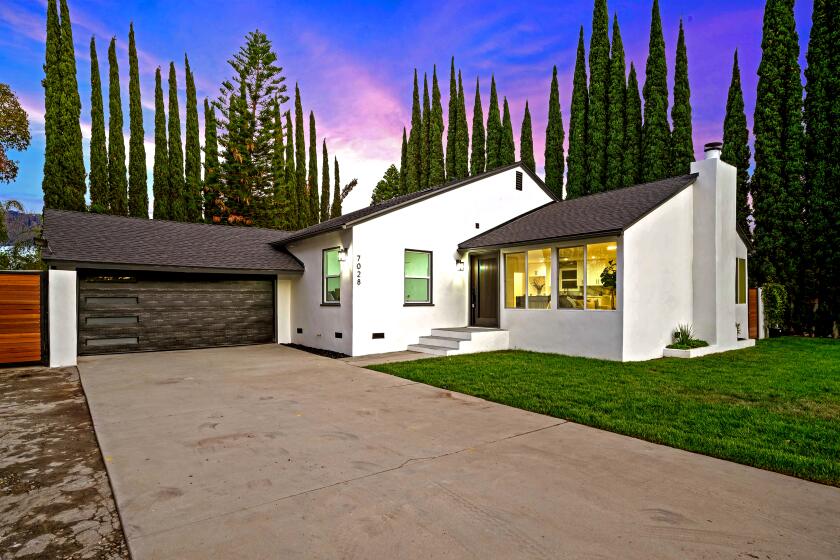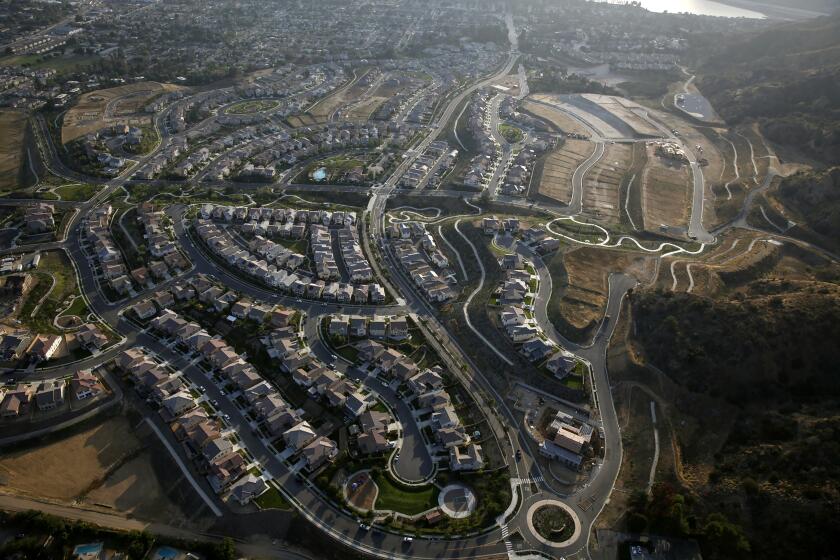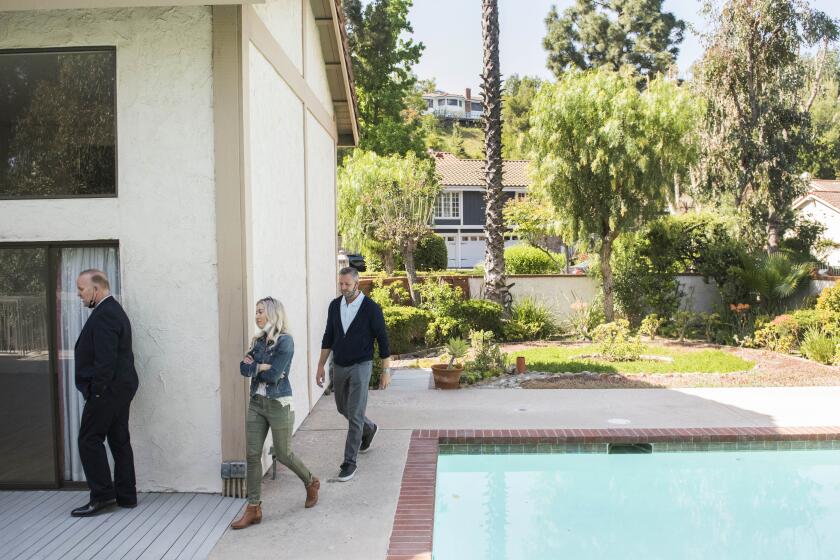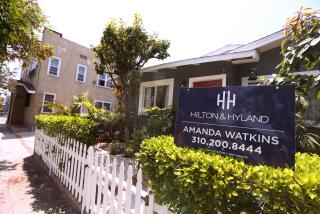- Share via
The pandemic economy pushed Southern California’s competitive housing market into such overdrive that a defining marker of wealth — the million-dollar home — has become the norm in a growing number of places.
Homes worth $1 million or more now dominate communities from Altadena at the foot of the San Gabriel Mountains to West Adams in South L.A. As bidding wars send prices even higher, more people are being priced out of communities where they grew up and homeownership is becoming more out of reach for low- and middle-income Californians.
At the same time, the proliferation of million-dollar homes shows that the price point is not a stretch for a growing share of Californians. It still requires financial strength to purchase such a home, but a surging stock market, rising incomes and historically low borrowing costs have made the $1-million house more common than ever.
That convergence of factors during the pandemic has reinforced the inequality of life in America: High earners are making, or at least saving, more money while grounded and working from home as millions of households are behind on rent.
With homes selling at a record pace, many to buyers paying well over the asking price, The Times set out to understand more about the forces shaping the pandemic real estate market: Who are the buyers behind these frenzied sales, and what is motivating and enabling them?
A data analysis showed the spread of homes valued at or more than $1 million across a geographic span. As of July, there were 55 cities and unincorporated areas in Los Angeles and Orange counties where the “typical” value of a single-family home was $1 million or more, according to a formula devised by online real estate company Zillow.
Do you live among million-dollar homes? These 15 L.A. neighborhoods crossed the $1-million threshold
Seventeen of those places — including Burbank, Fountain Valley and Torrance — crossed the $1-million threshold during the pandemic.
In the city of Los Angeles, 15 neighborhoods have hit the $1-million valuation since March 2020. In Leimert Park, Woodland Hills, Eagle Rock — among others — the typical home is now valued at $1 million or more.
Alec Zopf and Dee Foster beat out 27 offers and 15 counteroffers — three of them all cash — for their new home in Highland Park. They ended up paying nearly $280,000 more than the original list price. A heartfelt letter accompanied their $1.175-million bid, to make it stand out from the crowd.
“During the process, I was thinking, ‘I’m a reasonable person and won’t be bullied into making an unreasonable choice,’” Zopf said. “But I also knew that initial price was artificially low to attract more bidders.”
California has faced the million-dollar house boom with previous rising real estate markets. But during each expansion, the valuation enters new communities, or grows more common in neighborhoods where $1 million once bought a lot more.
“I don’t even have two bathrooms,” said Alan Torres, a 35-year-old software engineer, who along with his wife, Vanya, recently paid $1.04 million for a two-bedroom, one-bathroom house in Echo Park.
A search of the Multiple Listing Service shows data for 198 homes that have sold for between $1 million and $1.1 million in the city of L.A. so far this year. Of those, none is bigger than 3,000 square feet; 25 are less than 1,000 square feet.
The overall median size in the city of L.A. is 1,500 square feet of living space with three bedrooms and two baths on a 5,500-square-foot lot.
“When I got into this business, a million-dollar home was a beautiful five-bedroom traditional-style home on a very large lot in a desirable area,” said Sotheby’s agent Maureen Hollingsworth, who has worked 41 years in Southern California real estate. “Today, it buys you a two-bedroom on a tiny lot.”
Take a look at what $1 million buys in six L.A. neighborhoods.
The boom reflects a broader upswing in the market. As real estate prices rise across the board, $500,000 houses become $600,000 houses and $1-million houses become $1.2-million houses.
The pandemic unleashed new home-buying demand, as people with means desperately wanted out of their cramped apartments and small houses. At the same time, many millennials are entering their 30s — the typical age of a first-time home buyer.
Meanwhile, mortgage rates below 3% lured more people and investors into the market, allowing them to bid aggressively on properties so limited that homes have been selling faster than in any time recorded.
Zopf and Foster kicked off their saga with an open house over FaceTime. The seller’s agent quickly let them know that offers were already stacking on the home listed at $899,000.
Though they originally wanted to stay under $1 million, they said they knew they could afford more. Nervous they’d lose out, they made an initial offer of $1.075 million, only to see the seller counter with $1.1 million.
Facing 15 other counterbidders, Zopf, 35, and Foster, 32, came back with $1.15 million, including a clause to raise to $1.175 million if their bid was matched.
It was, so the couple then changed tactics: They penned a note explaining their intentions to start a family in the home — along with an offer to let the seller rent the home for two months while the seller moved into their next place.
It worked — the three-bedroom cottage was theirs.
How is $1 million affordable?
The sharp growth in home prices since the onset of the pandemic, after years of steady increases, is raising more concern that low- and middle-income Californians are becoming priced out of homeownership.
Zillow data show the bottom, middle and top of the market have seen roughly equal price increases since the start of the pandemic. Data from Redfin show 10% of L.A. County homes sold this year between January and mid-August went for at least $100,000 over the asking price, compared with 2% during the same period in 2019.
Contributing to those sharp price increases is the fact that in some ways, housing — including the $1-million house — has become more affordable for a growing segment of buyers.
In early September 2006, if a buyer got the 6.47% average mortgage rate and put 20% down on a $1-million house, they would have a monthly mortgage payment of $6,266 a month, including property tax and insurance, according to a Redfin payment calculator.
In 2018, when interest rates were 4.54%, the same $1-million house, with the same down payment, would cost $5,298 a month.
Today, the monthly mortgage payment on that $1-million house would be $4,546, using the average rate for the week that ended Sept. 9 — 2.88%, according to Freddie Mac. That’s about $1,700 less than in 2006, and the equivalent of an entire monthly mortgage payment in some areas of the country.
Although the majority of households can’t afford that, there’s a sizable minority that can.
The people interviewed by The Times who paid $1 million or slightly more included first-time home buyers who are dual-income couples in their 30s and 20s, working in entertainment, engineering and tech jobs.
Lenders will readily approve loans for a $1-million house for households with annual incomes of $150,000 or more, with solid credit, a 20% down payment and minimal other debts, said Jeff Lazerson, a mortgage broker in Laguna Niguel.
Gov. Gavin Newsom signed legislation that allows more than one unit to be built on lots zoned for only one. It sounds technical, but it’s a major change in California housing policy. Here’s what it means.
According to census data, 8.4% of L.A. County households made between $150,000 and $199,999 in 2019. An additional 11.3% of households made more than $200,000 that year. In raw numbers, that’s about 655,000 households that made $150,000 or more in a county and state that economists say have long underbuilt housing relative to demand.
“If there is a limited supply of housing and there are all these high earners, housing increasingly becomes like a luxury good,” said Redfin chief economist Daryl Fairweather. “People with deep pockets can keep bidding the prices up.”
Coming up with a 20% down payment — even 10% — can take years, even for six-figure earners. Buying a house with less money down is possible if someone can handle a higher monthly payment.
The pandemic economy has been good for many high-income families. High earners have been able to work from home and save on big-ticket spending, including on travel. The booming stock market, in particular, is funding down payments, as stock owners cash in on Wall Street’s record highs.
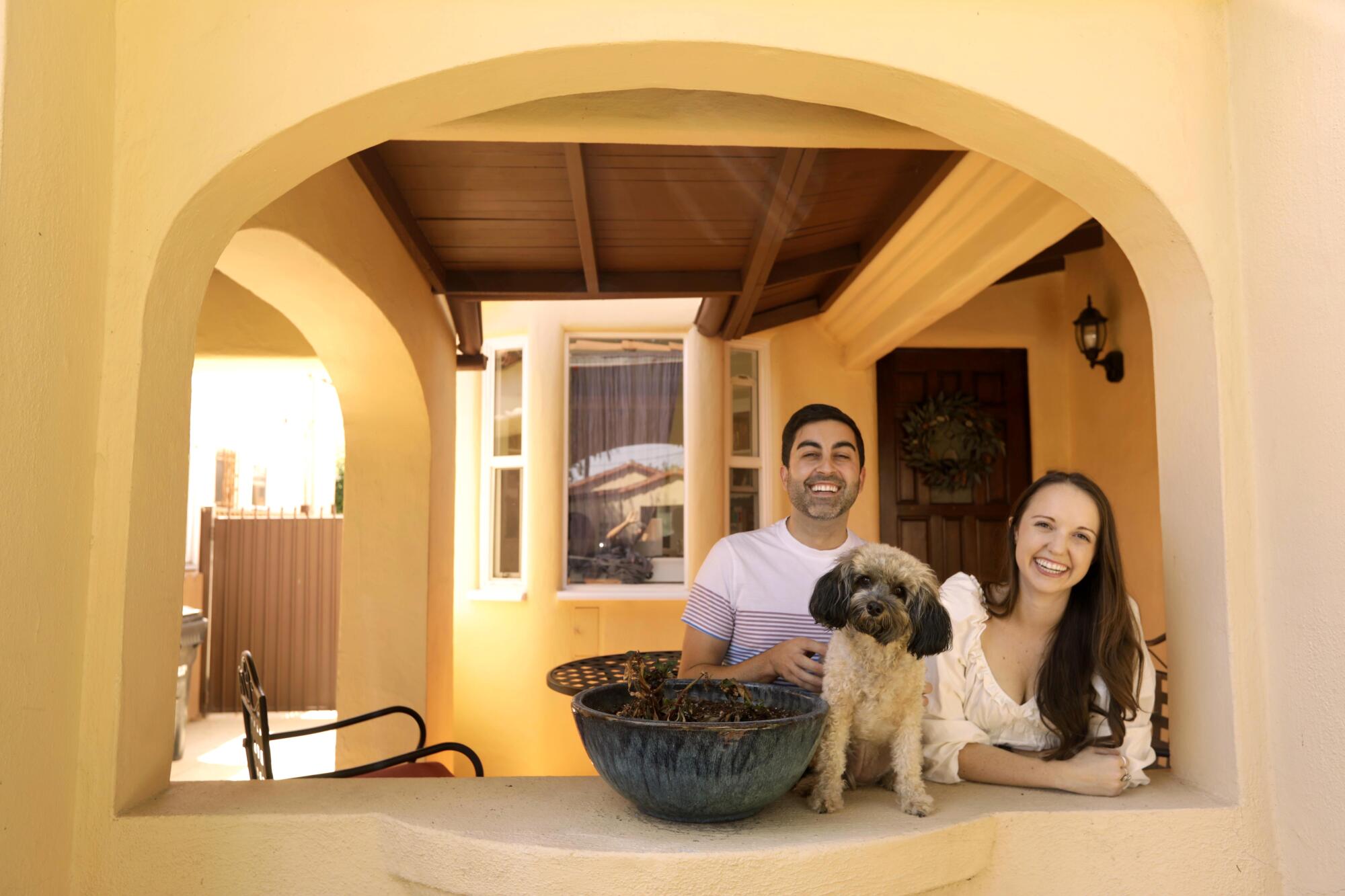
For some young first-time buyers, help from family is common. Others have scrimped and saved.
“It felt like time,” said Devin Sunseri, who bought a two-bedroom house in Leimert Park in April with his then-fiancee, Katie Scardino. The couple wanted to become homeowners before they tied the knot, which they did last weekend.
Family help allowed the couple to gather the 20% down payment and avoid private mortgage insurance on their $1-million house. Sunseri, 35, said they could have qualified without help, given personal savings and their annual household income — they make roughly $225,000 together, Sunseri as a producer in reality television and Katie, 29, as a manager with an online tutoring company.
Zopf, co-founder of the healthcare company Wellth, said he received a windfall from a New York startup he invested in that recently sold to Pandora. Combined with the couple’s income, they saved just enough to afford a $120,000, or 10%, down payment on a 30-year loan with a 3.5% interest rate.
Torres, the Echo Park buyer, said he and his wife used savings, plus a relatively new financial invention: About half their down payment came from the sale of investments in Ether, a cryptocurrency.
For those who bought years ago, they’ve been able to climb the equity ladder and make a neat — and fat — exit toward the $1-million price point.
Stacey Mamasig and her husband, Paul, in May sold their house in South L.A.’s Vermont Square for $725,000 in search of better-rated schools for their two children.
Mamasig, a 37-year-old real estate asset manager, said she bought the house for $360,000 in 2015. The equity funded their entire 30% down payment on a $1-million house in Torrance.
Without such a sizable sum, Mamasig said, getting into a $1-million house would have required getting “cheaper cars, or you know, [doing] other things to move the finances around.”
Go East
Making the market more competitive and eating into crucial supply are investors, who buy houses to rent out or to renovate and sell off.
In the second quarter of this year, 23% of L.A. County homes that sold were purchased by investors, rather than someone who wanted to live there, according to a data analysis by John Burns Real Estate Consulting.
That share is below a peak after the Great Recession, when many traditional buyers were locked out of the market, but up slightly from 2019 and about 10 percentage points higher than during the housing bubble of the mid-2000s.
“Prices would not be going up at the rate that they are if you didn’t have investors as active in the market as they are today,” said Rick Palacios Jr., research director at John Burns Real Estate Consulting.
Most buyers, though, are still people looking to call a house a home. In a recurring Southern California trend, many find they must head east to achieve that dream, driving up prices in neighborhoods more affordable to them.
In Altadena, buyers looking for larger homes are moving from L.A.’s Westside and central areas, newly undeterred by commutes since they are working from home, said Jessica Webb-Simpson, an agent at Figure 8 Realty.
In Torrance, many buyers are people who were paying sky-high rents to live in the beach communities of Manhattan Beach, Redondo Beach and Hermosa Beach, said Melissa Pilon, a South Bay agent at Compass.
Torres, the new Echo Park homeowner, originally wanted to stay on the Westside of L.A. where he and his wife rented, but they realized that even with their sizable budget they couldn’t find a house they liked at a price they could afford.
Homes are flying off the market at a record pace thanks to a perfect storm: pandemic-induced demand for more space, low supply, and apps that make it easier to view, bid for and buy houses — all with a few swipes and clicks.
Like Echo Park, several other newly minted million-dollar neighborhoods, such as Highland Park in northeast L.A. and Leimert Park and West Adams in South L.A., are places where soaring home prices and rents have over the last decade brought significant, and sometimes jarring, change.
As wealthier, often white, people move into Latino and Black neighborhoods that are predominantly low- and middle-income, longtime residents face displacement. New businesses price out local shops.
Gina Fields, a Leimert Park resident and chair of the neighborhood council for the majority Black neighborhood, said the rise in prices is in some ways positive, as longtime homeowners build sizable generational wealth.
At the same time, given racial economic disparities, Fields said there’s fear Black Americans will lose their majority in a neighborhood they had to struggle to make their own to begin with — fighting racist housing laws to build Leimert Park into the cultural heart of Black L.A. Today, it’s a place Fields said Black residents can feel at ease and not profiled by neighbors.
To keep people in their communities, Fields said she’d like to see more accessible loan products, more home-buying education and better job opportunities.
“The problem isn’t the housing price,” she said. “The problem is more the systemic racism that we face,” including challenges that Black Americans have getting mortgages and high-paying jobs.
Many real estate analysts predict prices will keep rising in the near future, given the mismatch between supply and demand. But they say price increases should become smaller because people don’t make enough money to sustain the current level of annual price gains, which hovered around 20% in recent months.
Already, there are some signs the market is cooling as burned-out home shoppers call it quits.
Ed Pinto, director of the American Enterprise Institute’s Housing Center, said mass defaults like those seen when the mid-2000s bubble popped aren’t a fear this time around, given far tighter lending standards. But if mortgage rates rise to 4.5%, which they did in 2018, Pinto said, L.A. County home prices would probably decline because buyers wouldn’t be able to afford what they can today.
“We are not talking about a risk of mass foreclosures. We are talking about a risk of somebody buying a house at $800,000 or $900,000 and the price goes down 10% to 15%,” he said. “As long as they don’t have to sell, it’s a paper loss.”
At the moment, the investment of some recent buyers looks to be paying off — at least on paper.
Scott Diorio, a 44-year-old software engineer, and Sarah Spada, a fashion business owner, jumped on the equity train in May. The couple paid $1.15 million — $251,000 higher than the list price — for a 1,100-square-foot Eagle Rock bungalow.
They said the price was tough to stomach, but they’d grown tired of losing out to all-cash offers and decided to be extremely aggressive.
“We’re still shocked we paid that much,” Spada, 39, said, “but the Redfin estimate already has the property at $100,000 more than we paid.”
More to Read
Inside the business of entertainment
The Wide Shot brings you news, analysis and insights on everything from streaming wars to production — and what it all means for the future.
You may occasionally receive promotional content from the Los Angeles Times.

